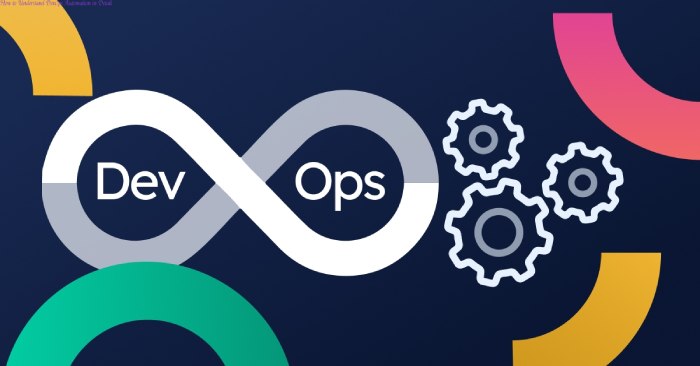How to Understand DevOps Automation in Detail

How to Understand DevOps Automation in Detail
Table of Contents
Introduction
DevOps Automation is using technology to carry out tasks with less human assistance to establish feedback loops between the development and operations teams. This speeds up the deployment of iterative updates to live applications.
DevOps practises depend heavily on automation; automating everything is one of their core tenets. Code generation on the developer‘s machine is the first step in automation, which continues until the code is pushed. Then, production monitoring of the system and application follows.
DevOps practice’s primary focus is automating infrastructure configurations, setups, and software deployment. The DevOps methodology depends on automation to produce quickly and consistently across platforms. The quantity of delivery, reliability, precision, consistency, and speed all rise thanks to DevOps automation. DevOps automation includes all process aspects, including development, deployment, and monitoring.
You can find all the information you require regarding DevOps Automation in this article.
Describe DevOps.
DevOps is a platform design, culture, and automation approach that strives to deliver high-quality services as rapidly as possible to maximize business value and responsiveness. DevOps practises uniting members of the operations and development teams into a single DevOps team.
This quickens and streamlines moving ideas and projects from development to production. DevOps uses more dynamic infrastructure and frequent code changes than manual or traditional management techniques.
Describe automation.
Software developers need IT resources to regularly deploy, test, and build new services and applications. Manual or conventional IT procedures can bog down the service delivery pipeline and waste resources. It can hinder the performance of concepts, slowing down development. By merging API-centric architecture with automation, IT teams may provide resources for proof of deployment, testing, development, and vision more quickly.
Concerning DevOps automation
The path to DevOps automation is ever-evolving. Before discussing the top DevOps automation solutions, it’s essential to consider a few general principles when choosing what and how to automate.
Choose open standards.
Your tools don’t have to change because your team and contributors do. By maintaining devices that follow universal open standards, you can simplify onboarding and reduce the money they spend on training. The community drives storage, networking, configuration, runtime, and packaging standards as deployments and DevOps shift to the cloud.
Utilise dynamic variables.
Reusable codes should always be a top priority because they will reduce duplication and rework both now and in the future. Applying automation in different environments is simple and doesn’t require changing the code entirely, thanks to externally defined variables protected in specialized tools or scripts.
Utilise transportable, flexible tooling
Finding a tool that works in every circumstance might not always be achievable. When/if organizations shift course, DevOps solutions enable you to transition technologies and minimize rework.
You can define your own set of optimal practises and accomplish your goals without being limited by employing just one toolchain by choosing solutions with a varied ecosystem and several integrations that function with any cloud. This list of data integration tools can serve as the foundation for your daily Rolodex of tools.
Tools for DevOps automation
The six categories of large DevOps teams that continue to operate significant, massive IT infrastructures are as follows:
Facilities Automation
You don’t have to be present in the data centre to use AWS (Amazon Web Services), as they are a cloud service. Instead, they don’t require any upfront hardware costs and may scale readily as needed. More servers can be made available automatically based on traffic.
Implementation Management
Chef: It is a valuable DevOps tool for boosting reliability, scale, and speed. It is possible to use it to maintain setups and automate complex tasks. With this tool, the DevOps team may stop specific server modifications on as many as feasible. They must make the modifications in one place, though, and the other servers will also receive a copy of them.
Implementation Automation
Jenkins: It streamlines continuous integration and testing. It facilitates effective project change integration by promptly locating issues when the build is implemented.
Control of Performance
App Dynamic: It continuously tracks performance. With the use of this technology, all the data and information are gathered when issues develop. Even developers who are debugging can use it.
Control of Logs
Splunk: This DevOps tool aids with issues with gathering, analyzing, and storing all logs in one location.
Monitoring
When infrastructure or any connected service is unavailable, Nagios monitoring notifies users. The primary function of this tool is to help the DevOps team recognize and address problems as they arise.
Making use of DevOps automation
Automation is a crucial tool to complete DevOps work amongst diverse teams. If you are new to DevOps or have come from other automation solutions, testing new tools with numerous processes or projects is a great place to start. You may create the foundation for standardizing and scalability of automation across your organization with DevOps Automation.
Thanks to it, you’ll even learn how to gauge your performance in achieving your ultimate goals. This practice has been broadly embraced across many industries, whether through internal teams or DevOps-as-a-service companies. What is DevOps as a Service, though? Please learn more about this choice because it might be the best one for your business.
Conclusion
For any kind of organization, software is a crucial component. As organizations around the world embrace digitalization, its use will only increase. Increased teamwork and free-flowing communication have resulted from it.
You will be able to meet customer wants better, make business goals more rapidly, and have more faith in the apps they create. Regardless of the tooling you use to automate your DevOps workflow, choosing a platform or tool will be easier if you first evaluate the data and workflows of your team. You can even use it to plan and prepare for a successful future.




